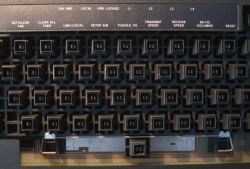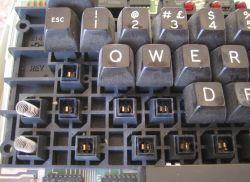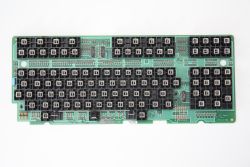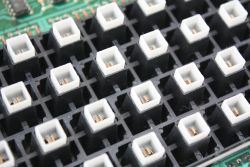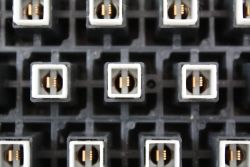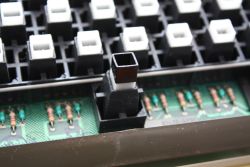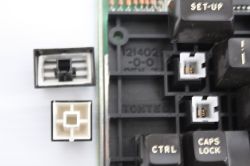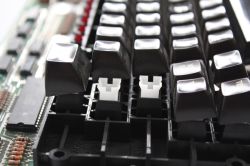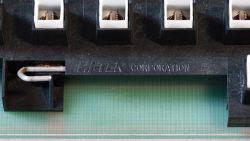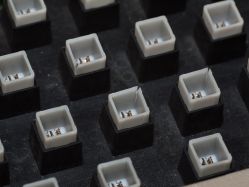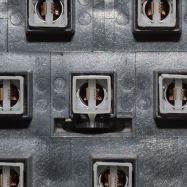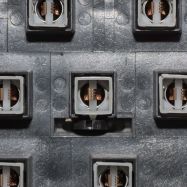Hi-Tek High Profile
| Manufacturer | Hi-Tek Corporation |
|---|---|
| Switch type | Linear |
| Sense method | Metal leaf |
| Switch mount | PCB mount |
| Patents | US3751618 (1972) |
Hi-Tek High Profile, formerly referred to as Hi-Tek linear, is a family of switch grids from Hi-Tek Corporation.
Nomenclature[edit | edit source]
"High Profile" (also referred to as "Hi-Profile") is believed to be a retronym introduced by Hi-Tek following the introduction of Hi-Tek Series 725; prior to this, these switches seem to have had no series name.<ref name="Corr-DH-SK-1" />
Description[edit | edit source]
The design depicted in the patent, with circular sliders, was designed for calculator keypads. In order to support full-size keyboards, a new grid system was introduced, made from discrete single-key mould units that could be assembled to mould entire keyboards; prior to this, it seems that the mould layout was entirely static.<ref name="Corr-DH-SK-1" /> Thin ridges around the grid walls demonstrate where the mould units are placed together to generate the overall grid moulding.
Each switch position takes up the entire unit. Since the contact and slider portion only needs to occupy the centre, the rest of the assembly is mostly empty space, with a wall around each switch position and bracing struts up to the centre shaft. The appearance of this largely-empty grid earned the design the nickname "waffle frame".
The switch contacts are a pair of vertical leaf springs placed side by side, that are held apart by a horizontal bar in the slider. When the slider is depressed, the bar is lowered and the contacts close. The slider is hollow, and the contacts are exposed when the keycap is removed. The return spring has a tight cluster of turns in the centre as well as at each end; this and the general design of the contacts are both found in the successor Hi-Tek Series 725.
Slightly prior to Series 725, Hi-Tek later introduced Dovetail Series, a modular, interlocking revision of the High Profile design that allowed for easier and cheaper construction of custom keyboards. Instead of requiring a full custom mould arrangement for each new keyboard, discrete and semi-discrete switches together with spacers could be joined together to form a larger grid.
Recognition[edit | edit source]
In many cases, Hi-Tek supplied only the switch grid, leaving the customer to supply the PCB and logic circuitry.<ref name="DMilo-T" /> The result of this is that may Hi-Tek switch grids have no branding; branding on the original-style switch grids is extremely rare. Hi-Tek as a manufacturer is generally confirmed by branding on the PCB, in the instances where Hi-Tek supplied complete keyboard assemblies.<ref>Deskthority — Hi-Tek keyboard</ref> With flat-top grids, however, the Hi-Tek branding is placed above the space bar.
As Stackpole grids are also frequently unbranded in the same manner, this created much confusion about differentiating Stackpole and Hi-Tek grids. However, the distinctions between the two now seem fairly clear.
Variants[edit | edit source]
Waffle frame, black[edit | edit source]
These switches are often found in DEC terminal keyboards. The separator bar in the slider features an "island", a raised area with semicircular ends. This raised area often contains three dots in a row, which appear to be artefact of the manufacturing process as they can be misshapen, found either side of the island, or simply absent. The purpose of the island is not known, although it may increase the pretravel and actuation force very slightly.
-
Switches from a DEC VT100
-
Switch detail; the switches with the long springs are weighted more heavily
Waffle frame, colourless[edit | edit source]
This is very similar to the black variety, but the separator bars lack the island in the centre.
The example below is from a Hewlett Packard 2623A keyboard.
-
Keyboard mechanism top
-
Keyswitch profile
-
Keyswitch overhead
-
Space bar slider
Crenellated[edit | edit source]
The crenellated version is not confirmed to be Hi-Tek. It seems to be specific to the DEC VT100 keyboard, although that keyboard also uses regular black sliders.
The top of each slider is flared, and a rectangular notch is cut into each of the four sides. No explanation for this variation is known.
-
DEC VT100 switches and keycaps
-
Side view
Flat-top[edit | edit source]
Flat-top switches are effectively the same as the colourless-slider waffle frame grid, but the switch positions have a top surface to them instead of an open grid frame. These grids tend to have the branding and patent number in the centre by the space bar.
-
Branding above the space bar on a Perkin-Elmer 3700 keyboard's main grid moulding
-
Hi-Tek and Stackpole switches are known for the fragility of the sliders, which are prone to splitting at the corners
-
Contacts in open state, held apart by the separator bar
-
Contacts in closed state (depicted via a Hi-Tek lock switch)
Servicing and parts[edit | edit source]
Computer service manual findings show that, as the switch grid is monolithic, there were provisions made to service individual switches. Each switch component was assigned its own part number, and an insertion tool was available to assist with insertion of replacement contacts. Section 5.6.6 of the Lear Siegler ADM-3A maintenance manual contains an illustrated guide to replacing a pair of switch contacts using the insertion tool. This in itself appears to confirm that the ADM-3A keyboard was supplied by Hi-Tek (unless Stackpole used Hi-Tek part numbers).
The following part numbers have been found:
| Part | Part numbers |
|---|---|
| Plunger, momentary | 173-40213 (NABU 3100) |
| Plunger, locking | 173-40334 (NABU 3100) |
| Cam, locking | 173-40260 (NABU 3100) |
| Spring, 2 oz | none (NABU 3100) |
| Contact, solid | 173-30107 (NABU 3100) 373-30052-2 (LSI ADM-3A) |
| Contact, fingered | 173-30108 (NABU 3100) 373-30053-2 (LSI ADM-3A) |
| Tool for contact replacement | 173-10023 (NABU 3100) |
| Stabiliser wire (8 units) | 373-10020 (CDC IST II) |
| Stabiliser wire clip | 373-30104 (CDC IST II) |
| Stabiliser insert | 373-30105 (CDC IST II) |
The NABU 3100 (formerly Volker-Craig VC3100) keyboard has yet to be seen, and it may be that some of these parts are specific to Hi-Tek Dovetail Series.
The CDC IST II service manual also cites a 2 oz spring for normal keys, and a 3 oz spring for the space bar.
Keyboards[edit | edit source]
For keyboards built using the modular grid, see Hi-Tek Dovetail Series.
Confirmed[edit | edit source]
- Some Atari 800 microcomputers: Stackpole<ref name="AtariAge-600-800" /><ref name="AtariAge-800" /> and Hi-Tek<ref name="AtariAge-HiTek" />
- Dragon Data Pippin prototype (white, waffle frame, with white numbering, 1981)<ref name="Pippin" />
- Lear Siegler ADM-3A terminal keyboard<ref name="ADM-3A" />
- Perkin-Elmer 55000-0147 (white, waffle frame)
- Perkin-Elmer 3700 keyboard (white, flat top and waffle frame)
- Some Rockwell AIM-65 microcomputers (white, waffle frame, part number 373-70125)
- Some Texas Instruments TI-99/4A (white, waffle frame)
- Volker Craig VC4152 terminal keyboard (white, flat top and waffle frame, with white numbering, 1981)<ref name="DT-VC4152" />
Unconfirmed[edit | edit source]
The following keyboards are being assumed to be Hi-Tek, but due to lack of Hi-Tek branding, remain unconfirmed:
- DEC DECWriter LA36(?) keyboard, manufactured by Cherry US (black sliders)<ref name="DECWriter" />
- Cherry DECWriter II UB80-01AA Mechanical Keyboard LK001-A<ref>https://www.ebay.com/itm/Vintage-Cherry-DECWriter-II-UB80-01AA-Mechanical-Keyboard-LK001-A-No-Keycaps/184189179230 Retrieved November 11, 2020.
Stamped on back of PCB in upper right corner:
LK001-A KEYBOARD
5013173 A SIDE 2
5413174
CHERRY [Cherry logo] ©
Stamped on front of PCB, middle left
CHERRY [Cherry logo] ©
Stamped on PCB, upper right
digital (all letters in boxes; i.e. digital logo)</ref>
- DEC GIGI terminal keyboard (black sliders)<ref name="DEC-GIGI" />
- DEC VT100 terminal keyboard, with white and black slider variants
- Hewlett Packard 2623A terminal keyboard (white sliders)
- HP 2382A terminal keyboard (white sliders, and white serial numbers)<ref name="DT-HP2382A" />
- IMSAI IKB-1 Intelligent Keyboard (black sliders)<ref name="GH-IMSAI-IKB-1" />
- IMSAI IKB-2 (black sliders)
See also[edit | edit source]
References[edit | edit source]
<references> <ref name="AtariAge-HiTek">AtariAge Forms — 800 Restoration Dated 2012-11-24. Retrieved 2015-07-27.</ref> <ref name="AtariAge-800">AtariAge Forums — Hacking the Atari 800 Keyboard & CX85 Keypad onto a USB PC Keyboard Circuit Dated 2009-12-26. Retrievd 2015-07-27.</ref> <ref name="AtariAge-600-800">(Wayback Machine) AtariAge Forums — 600/800XL Keyboard variants Archived 2005-06-01.</ref> <ref name="DT-HP2382A">Deskthority — HP2382A terminal keyboard</ref> <ref name="ADM-3A">Vintagecomputer.net — Vintage Computer Photos subject: LSI ADM3A Retrieved 2015-07-27.</ref> <ref name="DEC-GIGI">The Vintage Computer Forums — keycaps: NOSCROLL and SETUP keys for DEC VT100 style keyboard Dated 2010-05-22. Retrieved 2015-07-27.</ref> <ref name="DECWriter">Geekhack — A visit to my local electronics shop Posted 2013-07-05. Retrieved 2015-07-27.</ref> <ref name="DT-VC4152">Deskthority — Volker Craig vc4152</ref> <ref name="Pippin">The Dragon Archive — Pippin Last updated 2014-12-06. Retrieved 2015-07-27.</ref> <ref name="GH-IMSAI-IKB-1">Geekhack — keyboard switches used in IMSAI IKB-1 from "Wargames" (1983) film Posted 2013-12-17. Retrieved 2015-07-27.</ref> <ref name="DMilo-T">Telephone conversation with D'Milo Hallerberg, 2015-08-03</ref> <ref name="Corr-DH-SK-1">Correspondence with D'Milo Hallerberg and Susan Kennedy, 2017-09-03</ref> </references>
